
REVIEW: For a couple of years, travel was my life. Not always the good kind where you get to see lots of interesting places. More like the kind where you see the inside of hotel and conference rooms as you work on site. Ever since I set up my first external monitor at home, I’ve found myself to be far more productive with one or two screens plus my laptop. Problem is that most travel monitors to this day are really not all that portable. The Limink S20 portable tri-screen monitor intends to change that. We’ll see about that…
What is it?
The Limink S20 portable tri-screen monitor is a travel monitor that manages to squeeze multiple screens into the same space as most single travel monitors.
What’s in the box?
- Limink S20 portable tri-screen monitor
- Four sets of USB-C to C cables
- Two sets of mini-HDMI to HDMI cables
- Instruction manual
What are the specs?
First, let’s get the flashlight to expose the elephant hiding behind the couch: regardless of the name, this is not in and of itself a triple screen setup. The third screen alluded to in the name is actually your laptop’s screen. That said, the specs:
- Two 15.4-inch full HD screens (1920 x 1080, 16:9 aspect ratio)
- 60Hz refresh rate
- 1000:1 contrast ratio
- High Dynamic Range (HDR) support
- Weight (minus cables): 3.1 pounds
- Folded size (approximate): 9.5 inches high, 16 inches wide, 1.5 inches deep
- Display housing is made from aluminum
The setup supports laptops from 15.6 inch to 19-inch screens. It does this by expanding the middle connector panel that attaches to the dual monitors. Here is the panel at its smallest to accommodate a 15.6-inch display:
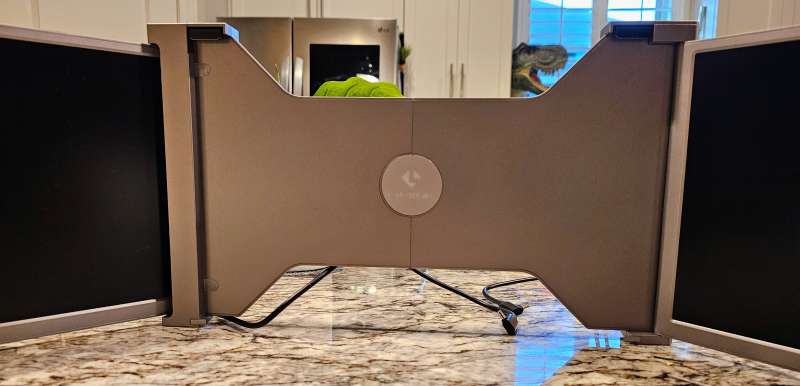
It’s not readily apparent in the picture, but the right display panel folds over the connecting panel while the left folds over the connecting panel’s backside for transport. Now here’s the panel opened up fully:
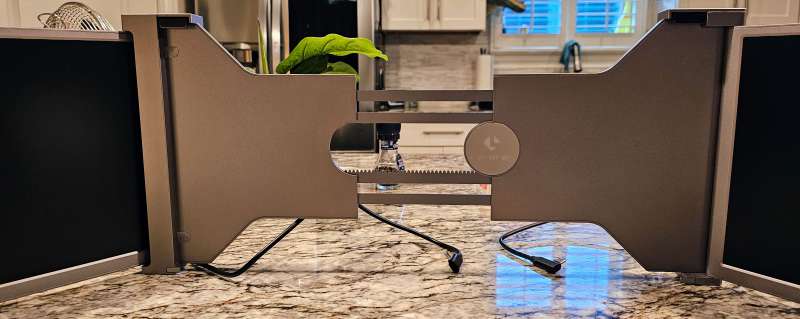
To secure this to the display panel of your laptop, the Limink uses a fixed width bar at the bottom and a spring-loaded clip at the top to handle differences in laptop display panel widths – first, the bottom:

And now the top:
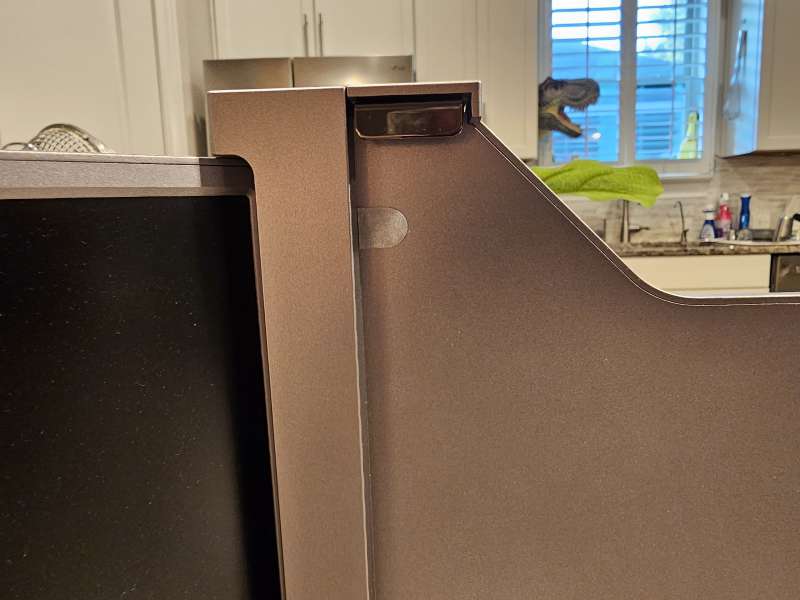
On the back side of the connecting panel there is a kickstand that helps keep the entire rig steady when mounted on your laptop:
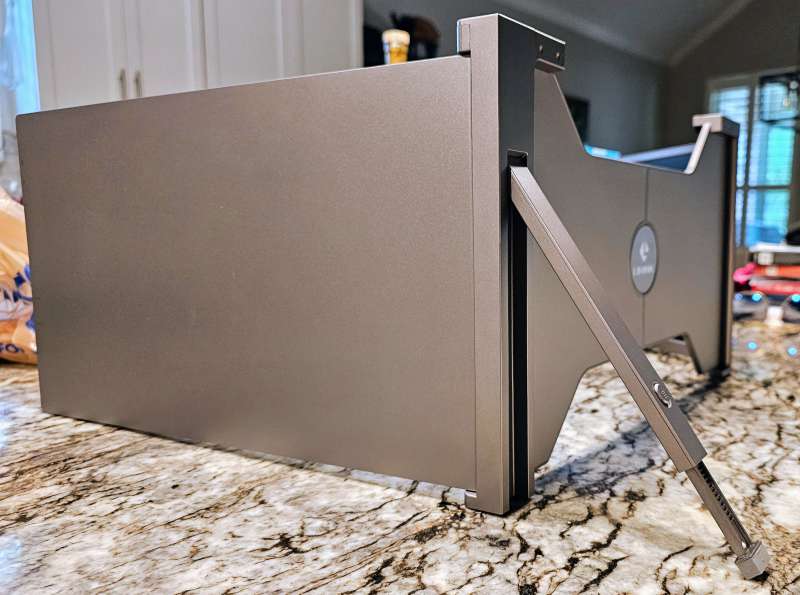
And now that we’re done, let’s fold it up and take it away:
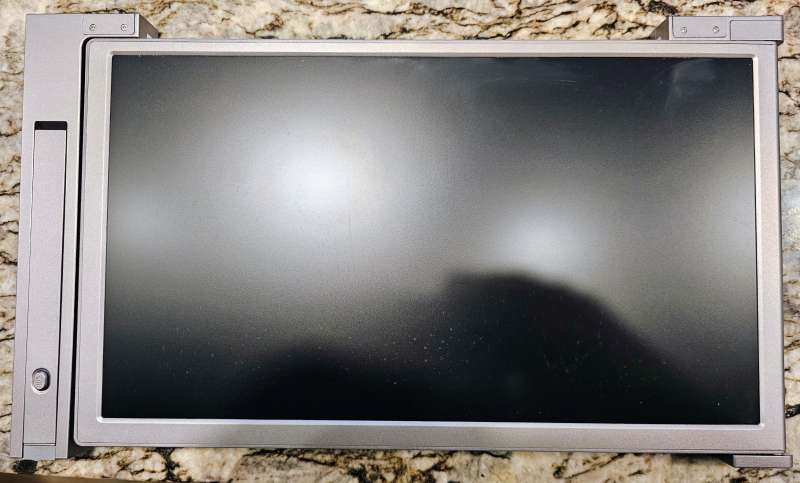
As you can see in the picture above, the left display panel is exposed when folded. You are definitely going to want to get a pouch or some other protection to prevent scratches to the screen.
On to the ports: each display panel has 2 USB-C ports and a mini-HDMI port. There’s also a Menu button and a rocker switch to let you select items from the on screen display:

So, why 2 USB-C ports? Older laptops can support video over USB-C but can’t deliver the necessary power to drive the monitor itself. Similarly, HDMI does not provide power to drive a monitor. Both USB-C ports on each display can handle video or power, depending on your needs. If you are in this situation, then one thing missing that you have to supply is a wall plug for power. Thunderbolt 3/4 ports do not generally have this limitation, so your Mac or most likely later model PC’s will not have the issue.
Does it work?
To test the Limink S20 portable tri-screen monitor, I used my Lenovo Ideapad and an older Thinkpad. Both are 15.6-inch screens, with the Ideapad being the newer model using an AMD Ryzen chip (vintage 2022). My Macbook Pro died literally days before the Limink arrived – don’t shed any tears, though. It had a long and healthy life, and died peacefully as I was attempting to compile some code (the Macbook was peaceful, although I can’t say the same for me – save your code early and often, and to someplace other than the deceased).
Let’s get the bad news out of the way: the Thinkpad is incredibly old and does not support video over USB-C (it has USB-C ports, though). It also does not have an HDMI port, instead favoring a funky mini DisplayPort. I could have bought an adapter to go between the DisplayPort and HDMI input on the Limink, but my thought was that I am now straying into the “not so portable after all” territory between the adapter and the power plug also needed.
The Ideapad is new-ish by comparison, so it was the next laptop into the lab. Once again, bad news reared its ugly head. Although there were plenty of USB-C ports (and 1 HDMI), none of them worked. At all. Not even a flash of light on the display. With or without power to the display panels. Just a whole lotta nothing.
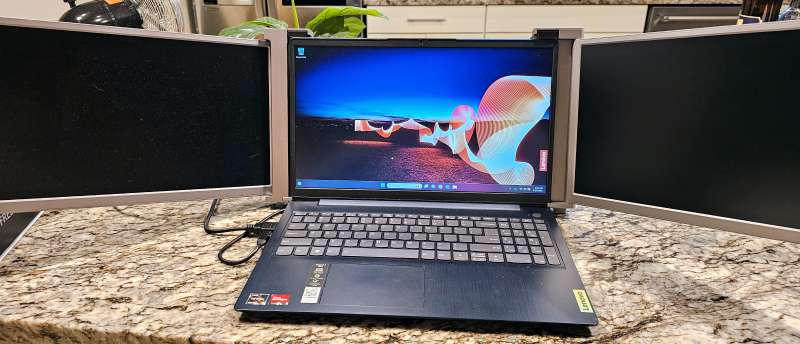
You might think at this point that there are issues with the Limink. There are not (more on that in a minute), but it does underscore an important point: be sure your equipment supports a high-end device like the Limink. That is, unless you are in the market for an expensive paperweight. And just because the manufacturer specs say so doesn’t mean it necessarily is. If I had spent a little time on Reddit, for example, I would have learned from other Ideapad users that even simple setups confound the Ryzen variation.
My final option before throwing in the towel was my Microsoft Surface Pro 8. First things first – the 2-1 tablet is too small to fit on the connecting panel of the Limink. So there was that issue. Plus Microsoft has had issues with their display drivers for a number of years now, issues like not working with some monitors or the external display(s) blacking out for a minute or two randomly (usually right as I was scheduled for a Teams meeting, so it was a bearable issue). Going in, I was pretty sure this was not going to work.

I was wrong.
Plugged into the two Thunderbolt 4 ports on the Surface (and no power needed), the twin displays lit up bright. The picture on both is clear and sharp, and in the more than 3 hours I worked with this setup not once did I have a display blackout, something that routinely happens when driving the two monitors on my desk. Of course, that also meant I didn’t have an excuse to miss the Teams meeting, but you have to take the really great with the not-so-great.
During those 3 hours, I edited a video for a community meeting at the end of the week. The color output is magnificent – vibrant and true to the actual color. And at full HD, I did not need to use my computer glasses to see the screen. I also wrote some code for a web project I am working on, and the resolution gave me sharp, easy to read text in the editor as well. It took me all of about 2 minutes to get over the fact that my Surface did not fit in the connecting panel – it just felt like a natural extension of my tablet/computer.
I have another single screen travel monitor I have used for the last 2 years. I’m going to miss that monitor, because the Limink is now my travel setup. Yeah, it is a little heavier than the old monitor, but the extra few ounces to carry is nothing compared to the benefit of 2 monitors in a well designed and built setup. I like this setup so much that I am going to build a 3D model of a block with a groove in it to give the display a little height off the table. I can’t say this enough – being driven by the right equipment, this is an unbeatable travel display.
What I like
- The displays are crisp, bright and colorful
- HDR inclusion makes this a great way to watch a YouTube video (not that I do this during work hours)
- The aircraft grade aluminum housing for the displays makes the entire setup feel premium without sacrificing weight or portability
What I’d change
- Charge a little more and put a zippered carrying case in the box (to protect the left monitor when transporting)
Final thoughts
At $649, the Limink S20 portable tri-screen monitor is not an inexpensive item. But, from the minute you open the box, you can see and feel every penny of that in everything from the build quality to the thoughtful inclusion of every cable you could need for any permutation of laptop ports. The display quality rivals what you would put on your desktop at home, the screen size is big enough to see plenty of code/spreadsheet data while not requiring a hand truck to get from place to place, and the true to color output makes it suitable for graphics or video work. In the end, if you have a laptop which supports the Limink inputs and you travel (regardless of frequency), you can easily be as productive as you are at home with the Limink S20 Portable Tri-Screen monitor.
Price: $649 (Currently on sale for $599 with an additional $50 off coupon on the Amazon page)
Where to buy: Amazon
Source: The sample for this review was provided by Limink.


